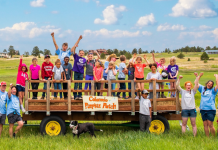 May is National Foster Care Month. According to childwelfare.gov, it’s a time to acknowledge foster parents, family members, volunteers, mentors, policymakers, child welfare professionals, and other members of the community who help children and youth in foster care find permanent homes and connections.
May is National Foster Care Month. According to childwelfare.gov, it’s a time to acknowledge foster parents, family members, volunteers, mentors, policymakers, child welfare professionals, and other members of the community who help children and youth in foster care find permanent homes and connections.
Despite the great number of people who work for the welfare of foster children, the statistics highlighting the dire need for support and the bleak outcomes for these children are staggering.
Nationally, around half a million children are in the foster care system.
Nearly 10,000 children spent time in foster care in Colorado in 2016. An average of 14 children were removed from their parents’ homes each day. About 12 percent of children are removed from their homes due to physical abuse and 61 percent for neglect. Thirty-four percent come to the foster care system because of parents’ drug abuse. Often, the reasons overlap or are multi-faceted. This does not include children who enter the system as refugees from other countries.
There is a need for both short-term and long-term foster families.
While many children end up in long-term foster care situations, more than half of children leaving foster care are reunited with their parents or primary caregivers. Another 23 percent are adopted, either by their foster parents or by non-foster parents.
According to national statistics, 40 to 50 percent of foster children never complete high school. Sixty-six percent of them will be homeless, go to jail or die within one year of leaving the foster system at age 18. More than 23,000 children will age out of the US foster care system every year. After the age of 18, a full 20 percent will become instantly homeless. Only 50 percent will have some form of gainful employment by the age of 24. Girls in foster care are 600 times more likely than the general population to become pregnant before the age of 21.
Is it any wonder?
Children who enter the foster care system usually have experienced some level of trauma and/or abuse, including neglect, emotional abuse, physical abuse, sexual abuse, or child sex trafficking. They move from foster home to foster home an average of four to six times, with some moving up to 15 times.
73 percent of people in the prison system were in the foster care system at one time.
Foster children desperately want to be part of a family and belong. If they don’t find that family in a home, they will find it on the streets, in gangs, or in jail. Partly in order to maintain that sense of family, they become repeat offenders. They often become stuck in a system that doesn’t know how to treat adults looking for a place to belong. Many are a continuation of generational cycles of trauma, abuse, and lack of a healthy traditional family unit. The goal of the foster care program is to create that sense of family for these children before they become a part of those statistics once they age out of the system.
Have you considered becoming a foster parent? Have you considered opening your home and heart to children who desperately need love?
How to become a foster parent in Colorado:
- Attend the foster care program orientation.
- Complete and submit an application.
- Attend foster parent training classes sponsored by the county departments, private child placement agency, or the State of Colorado.
- Participate in a comprehensive foster family assessment.
There are a few basic qualifications. You must:
- Be 21 years of age or older.
- Have an extra bedroom in your home that can accommodate foster children.
- Have a valid Colorado driver’s license and have access to a reliable, Colorado-registered vehicle.
- Be financially stable without the income fostering will provide.
- Not smoke in your home or vehicle while fostering.
Furthermore, you need to possess a love for children as well as physical stamina and patience to commit to these foster children. If you would like more answers or are ready to apply to become a foster parent in Colorado, google foster care Colorado Springs to view a list of foster care services and choose the one that’s right for you.
Do you want to help, but don’t feel called to be a foster parent?
Part two of this series will provide you with ways you can support local foster children and foster parents.













